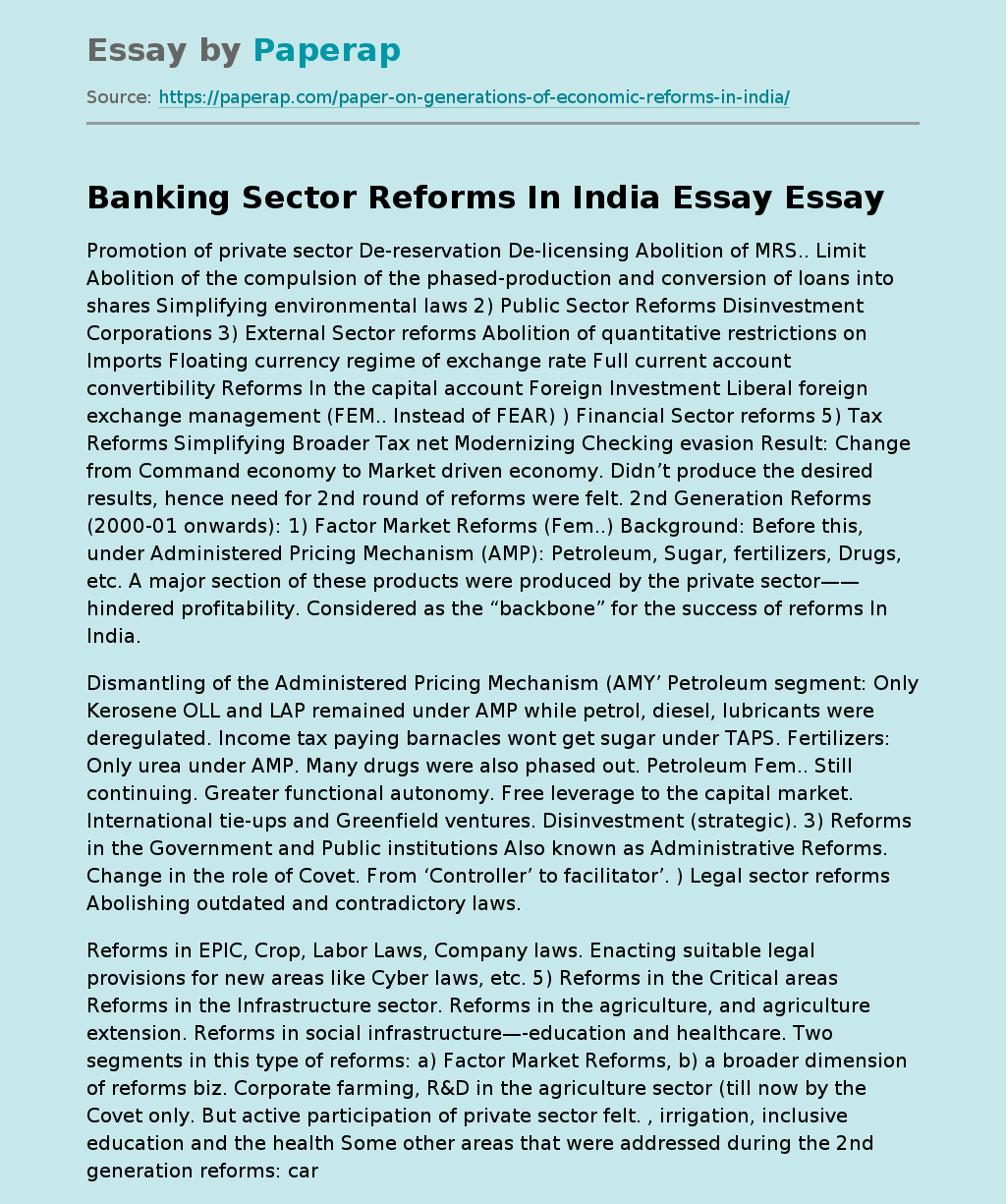Banking Sector Reforms In India
The following sample essay focuses on the reform of the banking sector in India. Read the introduction, body and conclusion of the essay, scroll down.
Dismantling of the Administered Pricing Mechanism (AMY’ Petroleum segment: Only Kerosene OLL and LAP remained under AMP while petrol, diesel, lubricants were deregulated. Income tax paying barnacles wont get sugar under TAPS. Fertilizers: Only urea under AMP. Many drugs were also phased out. Petroleum Fem.. Still continuing. Greater functional autonomy. Free leverage to the capital market.
International tie-ups and Greenfield ventures. Disinvestment (strategic). 3) Reforms in the Government and Public institutions Also known as Administrative Reforms. Change in the role of Covet. From ‘Controller’ to facilitator’. ) Legal sector reforms Abolishing outdated and contradictory laws.
Reforms in EPIC, Crop, Labor Laws, Company laws. Enacting suitable legal provisions for new areas like Cyber laws, etc. 5) Reforms in the Critical areas Reforms in the Infrastructure sector. Reforms in the agriculture, and agriculture extension. Reforms in social infrastructure—-education and healthcare.
Two segments in this type of reforms: a) Factor Market Reforms, b) a broader dimension of reforms biz. Corporate farming, R&D in the agriculture sector (till now by the Covet only. But active participation of private sector felt. , irrigation, inclusive education and the health Some other areas that were addressed during the 2nd generation reforms: care. ) Increase in importance of the states as initiator of reforms and Centre to play a supporting role. 2) Fiscal consolidation in the form of FROM Act, 2003 and Fiscal Responsibility Acts (FRATS) by the states.
3) Greater tax devolution to the states. 4) More focus on the social sector especially—-healthcare and education. 3rd Generation Reforms: Announced on the margin of launching the tenth plan I. E. 2002-2007. Provision for fully functional Penchant’ Raja Institutions (Pro’s). The Generation Reforms: Not an official generation of reform in India. Early 2002: A fully ‘Information Technology enabled’ India. A two way connection between the economic reforms and IT with each one reinforcing the other.
Second Generation Economic Reforms In India
Financial and Banking Sector Reforms Financial Sector Reforms: Background: A high level Committee on Financial System (CIFS) also known as Narcissism Committee I was set up on Gauge 1991 to examine all aspects relating to structure, organization, functioning, and procedures of the financial system— introduced in the fiscal 1992-93. The recommendations were aimed at: ) Greater operational flexibility. 2) Internal autonomy of Sobs in their decision making. 3) Greater degree of professionalism in banking operation. Recommendations of CIFS: 1) On Directed Investment: Advised the RIB to use Moms increasingly instead of relying on CAR. RIB should pay interest on CAR of bank at a specific rate.
The Covet. Should move towards market-based borrowing programmer so that the banks get benefits on their SSL investment. 2) On Directed Credit Programmer: Talks about Priority Sector Lending (SSL) by the banks. Should be phased out gradually. No more support required for priority sectors as they are already mature. Should not be a regular programmer—- —only in extraordinary cases such as weaker sections. Should be made temporary and not permanent. Should include only the weakest sections of the rural economy such as marginal farmers, rural artisans, village and cottage industries, tiny sector, etc. “Redefined SSL “—–10% of the aggregate bank credit.
Composition of SSL should be reviewed every 3 years. 3) On the Structure of Interest Rates: Interest rates— to be determined by market forces. All controls on interest rates on deposits and lending to be withdrawn. SSL concessions and RIDE subsidies to be phased out. RIB: Sole authority to simplify the structure of interest rates. Bank rate: The anchor rate; All other interest rates to be closely linked to it. 4) On the Structural Reorganization of the Bank: Substantial reduction in the number of Sobs- mergers and acquisitions- greater efficiency. Dual control of RIB and DES, MOB should be withdrawn; RIB: should be the primary agency of regulation. Sobs: To be made free and autonomous.
RIB to examine all guidelines and directives issued to Banks in the light of independence and autonomy of banks. ASS: Radical change in work technology and culture. Appointment of CM: Must be as per professionalism and integrity. An independent panel should be involved. 5) Asset Reconstruction Companies/ Fund: To tackle the menace of Naps. The Committee directly blamed the Gold and MOB for the sad state of affairs. Banking Sector Reforms: DCE 1997: Another committee set up on “Banking Sector Reforms”. Chairman: M. Narcissism Major Suggestions: Need for a stronger banking system; Mergers of the Sobs and Fails; The stronger ones to be merged while weaker ones to be closed. Tier banking structure suggested after mergers. ) Tier 1: 2-3 banks of international orientation. 2) Tier 2: 8-10 banks of national orientation. 3) Tier 3: A large number of local banks. Tier 1 & tier 2: To serve the corporate sector. Higher Capital to Risk Weighted Adequacy Ratio (CAR). Budgetary recapitulations of the Sobs not viable and hence to be abandoned. Provision for Loan recovery to be strengthened. Naps for all banks suggested to be cut down. Rationalization of branches and staffs of Sobs. License to new private banks. Banks board to be duplicities. Board for Financial Regulation and Supervision to be set up for banks, financial institutions and NBS.
Banking Sector Reforms In India. (2019, Dec 05). Retrieved from https://paperap.com/paper-on-generations-of-economic-reforms-in-india/

